THE MULTIDIMENSIONAL RELATIONSHIPS OF ORGANIZATIONAL TRUST TRANSFORMATIONAL LEADERSHIP TEAMWORK AND PUBLIC – PRIVATE PARTNERSHIP PROJECT SUCCESS: THE EVIDENCES FROM THAILAND
Keywords:
Organizational Trust, Transformational Leadership, Teamwork, Public – Privat Partnership ProjectsAbstract
The objectives of this research are to study found that: 1) To study impacts of transformational leadership and organizational trust upon Teamwork in the PPP project scheme. 2) To study impacts of organizational trust and transformational leadership and teamwork on PPP project success. 3) To study relationships of teamwork and PPP project success. The quantitative research used the sample. Including public and private sectors are Project Supervisor the owner of a consulting firm Agency representative From a joint investment project, the population, including the 70 joint venture projects, uses a specific selection method to collect data using 3 questionable experts that have a confidence value of 0.67 with an alpha coefficient of Cronbach 0.858 Data analysis by presenting structural model analysis. The results of the study the assumption that change leadership has a positive influence on the success of the project through teamwork as a medium. Reject the hypothesis of the relationship of teamwork and success of public-private investment projects. Path coefficient and significance level of coefficient at significance level 0.01. Hypotheses 1 and 5 will be rejected because P-value is greater than 0.01, while there are three accepted hypotheses which are hypotheses 2, 3 and 4) With suggestions If the sample selection is more diverse by examining other projects that may have better results and benefit the management and managers.
References
จุฑาทิพย์ สุจริตกุล. (2562). ภาวะผู้นำการเปลี่ยนแปลงของผู้บริหารองค์กรปกครองส่วนท้องถิ่นในยุคประเทศไทย 4.0 กรณีศึกษา: องค์กรปกครองส่วนท้องถิ่นจังหวัดภูเก็ต. วารสารมหาจุฬานาครทรรศน์, 6(10), 930 - 943.
พรทิพย์ ศิริภานุมาศ และคณะ. (2562). บทเรียนความเป็นไปได้การให้เอกชนร่วมลงทุนด้านสุขภาพของประเทศไทย. วารสารสำนักงานป้องกันควบคุมโรคที่ 6 ขอนแก่น, 26(1), 109 - 119.
ศศินิภา ทิวาลัย และวศิน เหลี่ยมปรีชา. (2555). การวัดประสิทธิผลด้านการให้บริการของระบบการบริหารลูกค้าสัมพันธ์ออนไลน์ของธุรกิจโรงแรมโดยการใช้แบบจำลองของดีลอนแอนด์แม็คคลีนและอีเมตริก. วารสารวิทยาการจัดการและสารสนเทศศาสตร์ มหาวิทยาลัยนเรศวร, 7(1), 89 - 95.
Amadi, C. N. et al. (2019). Natural antidotes and management of metal toxicity. Retrieved March 2, 2020, from https://www.researchgate.net/publication /333027071_Natural_antidotes_and_management_of_metal_toxicity
Chan. A. P. C. & Cheung, E. (2014). Public – private partnership in international construction Learning from case studies. Retrieved March 4, 2020, from from https://doi.org/10.4324/9780203736661
Choi, S. L. et al. (2016). Transformational Leadership, Empowerment, and Job Satisfaction: the Mediating Role of Employee Empowerment. Human Resources for Health, 14(73), 1-14.
Hair, J. F. et al. (2010). Multivariate Data Analysis: A Global Perspective. (7th Ed.). United States of America: Pearson Prentice Hall.
Hair, J. F. et al. (2011). PLS-SEM: Indeed a Silver Bullet. Journal of Marketing Theory and Practice, 19(2), 139 - 151.
Hair, J. F. et al . (2014). Partial least squares structural equation modeling (PLS-SEM)L an emerging tool for business research. European Business Review, 26(2), 106 – 121.
Harpen, G. W. E. B. V. (2002). Public Private Partnerships, the Advantages and Disadvantages Examined. Association for European Transport Report. Retrieved March 4, 2020, from http://trid.trb.org/view.aspx?id=803508
Henjewele, C. (2012). Analysis of factors affecting value for money in UK PFI projects. Journal of Financial Management of Property and Construction, 17(1), 9 - 28.
International Trade and Development Research Forum. (2017). Policy Brief on the Roles of Financial Institutions on Driving SGDs Goals. Retrieved March 4, 2020, fromhttps://sustainabledevelopment.un.org/content/documen ts/18041SDG7_Policy _Brief.pdf
Mandhachitara, R. & Poolthong Y. (2011). A Model of Customer Responsibility and Corporate Social Responsibility. Journal of Service Marketing, 25(2), 122 - 133.
Nicholas, C. et al. (2020). Critical Success Factors for Public-Private Partnership (PPP) Infrastructure and Housing Projects in Kenya. Retrieved March 4, 2020, from https://www.researchgate.net/publication/339828560
Nunnally, J. C. (1967). Psychometric theory. New York: McGraw-Hill.
Parish, T. et al. (2010). Becoming Competitive Amateur Bodybuilders Identification of Contributors. Psychology of Men & Masculinity, 11(2), 152-159.
Rwelamila, P. et al. (2012). Addressing the Missing Link in PPP Projects: What Constitutes the Public? Journal of Management in Engineering, 31(5), 1 - 28.
Schweitzer, J. (2014). Leadership and Innovation Capability Development in Strategic Alliances. Leadership and Organization Development Journal, 35(5), 442 - 469.
Tam, C. M. (1999). Build-operate-transfer model for infrastructure developments in Asia: reasons for successes and failures. International Journal of Management, 17(6), 377-382.
The State Enterprise Policy Office. (2017). Public Private Partnership (PPP) in Thailand. Retrieved March 4, 2020, from htpp://www.sepo.go.th.
Wolf, E. J. et al. (2013). Sample size requirements for structural equation models: an evaluation of power, bias, and solution propriety. Education and Psychology Measurement, 76(6), 913 – 934.






